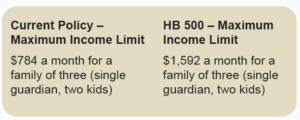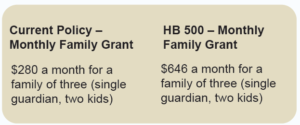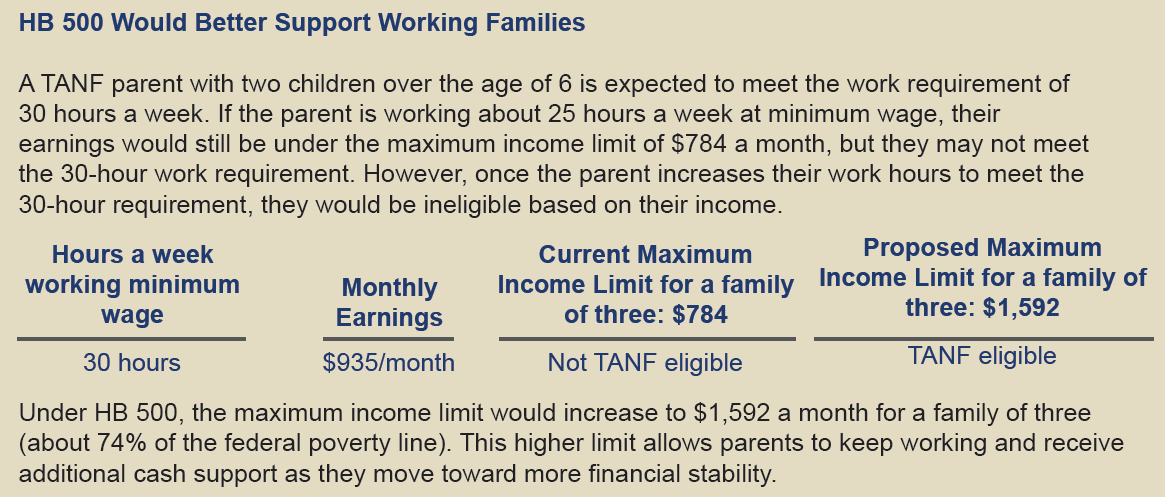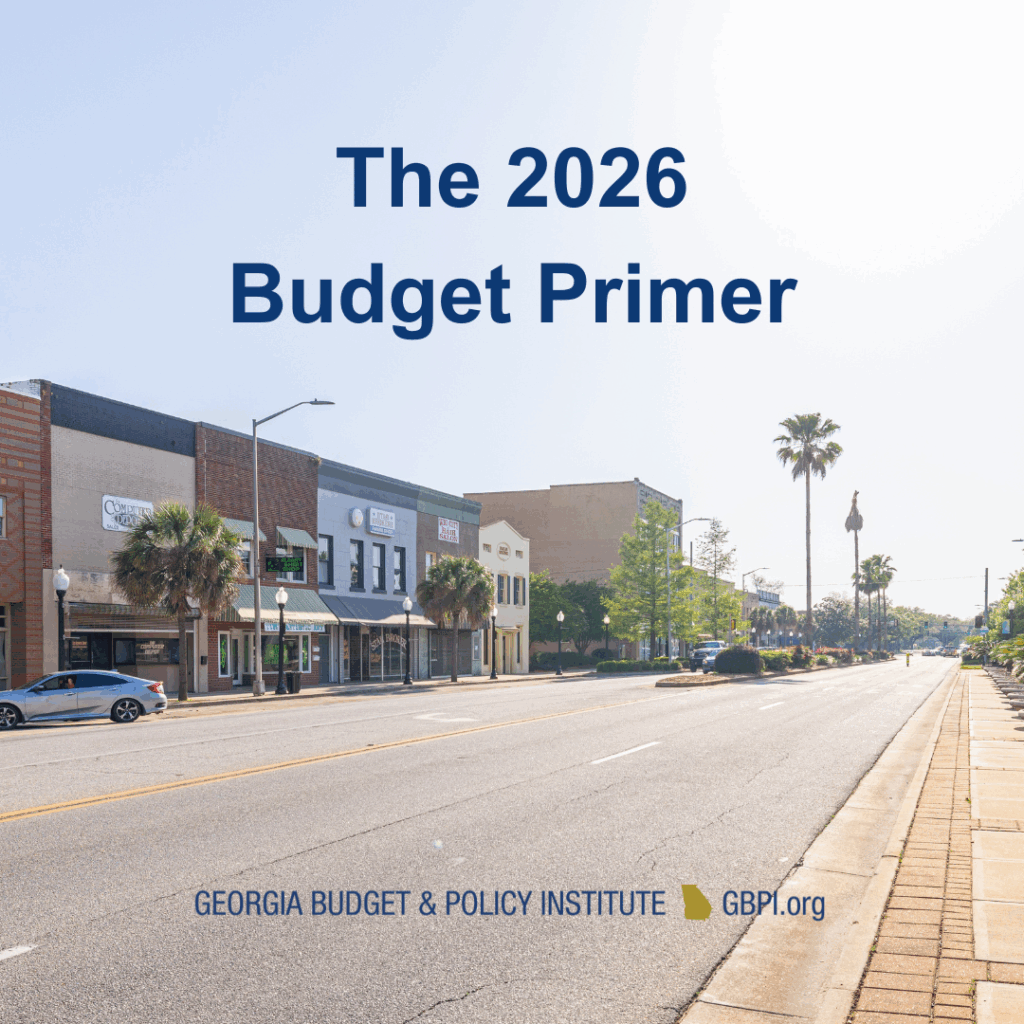Georgia’s Temporary Assistance for Needy Families (TANF) program has not been updated in 28 years. House Bill 500 would improve the program and make it better able to support working families and grandparents raising grandchildren.
Today, TANF provides minimal support to families with children living in poverty. Monthly benefits have lost nearly half of their inflation-adjusted value since the start of the program. The TANF caseload is now below 4,000 families.[1] In 2020, TANF reached about five out of every 100 Georgia families in poverty.[2] TANF is funded by a $330 million fixed but flexible federal block grant each year. The state must also meet a Maintenance of Effort (MOE) contribution of $173 million a year. Only about 3% of TANF spending goes towards cash assistance to TANF families.[3]
HB 500, which would increase benefits and expand eligibility, is moving through the legislature. It recently passed unanimously in the Public and Community Health Committee.
Though TANF cash assistance is modest, research finds that access to economic supports like TANF helps keep a family stable and improves the immediate and long-term well-being of children.[4] Under HB 500, working parents can work more hours and still receive some cash assistance to help them make ends meet. Most of the children on TANF live with a relative, often a grandparent. HB 500 would provide more support to relatives possibly keeping thousands of children out of the expensive foster care system.
What changes would HB 500 make?
A family applying for TANF benefits must have income below the maximum income threshold (also known as the gross income limit). Current levels are so low that an applicant with some earnings likely could be ineligible, or they could cut a family off the program before they are on a stable financial path. HB 500 would tie the maximum income limit to about 74% of the federal poverty line.
 Georgia’s monthly benefits are among the lowest in the country at about 13% of the federal poverty line. Benefits have not kept up with the cost of essentials like diapers, gas and groceries. This legislation would tie the monthly benefit to about 30% of the federal poverty line and would adjust to the growing cost of living.
Georgia’s monthly benefits are among the lowest in the country at about 13% of the federal poverty line. Benefits have not kept up with the cost of essentials like diapers, gas and groceries. This legislation would tie the monthly benefit to about 30% of the federal poverty line and would adjust to the growing cost of living.
Georgia’s TANF program has a $1,000 resource limit, and a family’s car must be valued at $4,650 or less. If a car is valued at more than $4,650, the excess cannot be more than the maximum resource limit of $1,000.[5] In a few cases, mothers have sold their cars to get TANF support.[6] HB 500 would increase the resource limit to $5,000 and allow a family to have at least one car regardless of value.
mothers have sold their cars to get TANF support.[6] HB 500 would increase the resource limit to $5,000 and allow a family to have at least one car regardless of value.
The bill also extends the time limit from 48 months to 60 months.
HB 500 does not change TANF’s work requirements
HB 500 would not change work requirements. Parents receiving TANF benefits must engage in work activities.
- Recipients with a child aged six or older must engage in a countable work activity for 30 hours a week.
- Recipients with a child under six are only required to work in a countable activity for 20 hours a week.[7]
TANF’s work and other requirements are very strict. Even with HB 500’s improvements, the state is not likely to see massive increases in the caseload because many families will be unable to meet these and other requirements.

How could these changes be funded?
The state underspends its federal block grant each year. Federal TANF funds could absorb changes made in HB 500 with no additional cost to the state.
Endnotes
[1] Georgia Department of Human Services, Division of Family and Children Services. (2020, January). Resources. Georgia division of family and children services TANF policy manual. https://pamms.dhs.ga.gov/dfcs/tanf/1505/
Georgia Department of Human Services, Division of Family and Children Services. (2020, January). Vehicles. Georgia division of family and children services TANF policy manual. https://pamms.dhs.ga.gov/dfcs/tanf/1515/
[2] Comments from Chairman Tyler Paul Smith during the February 24, 2025, Public and Community Health hearing.
[3] Georgia Department of Human Services, Division of Family and Children Services. (2020, January). Employment services. Georgia division of family and children services TANF policy manual. https://pamms.dhs.ga.gov/dfcs/tanf/1801/
[4] Data from the Georgia’s Department of Human Services’ Division of Family and Children Services
[5] Shrivastava, A., & Azito, Thompson, G. (2022, February 18). TANF cash assistance should reach millions more families to lessen hardship. Center on Budget and Policy Priorities. https://www.cbpp.org/research/family-income-support/cash-assistance-should-reach-millions-more-families
[6] Note: Under Basic Assistance of the ACF-196r, there are two spending categories. The first excludes relative foster care, adoption, and guardianship payments. This category only includes assistance payments to TANF families. The other category is for payments to relative foster care, adoption and guardianship families.
Administration for Children and Families Office of Family Assistance. (2024). Georgia: Federal TANF and state MOE expenditures summary by ACF-196r spending category, fy 2023. U.S. Department of Health and Human Services. https://acf.gov/sites/default/files/documents/ofa/fy2023_tanf_moe_state_piechart_georgia.pdf
[7] National Academies of Sciences, Engineering, and Medicine. (2019). A roadmap to reducing child poverty. https://nap.nationalacademies.org/catalog/25246/a-roadmap-to-reducing-child-poverty
Sherman, A. and Mitchell, T. (2017, July 17). Economic security programs help low-income children succeed over long term, many studies find. Center on Budget and Policy Priorities. https://www.cbpp.org/research/poverty-and-inequality/economic-security-programs-help-low-income-children-succeed-over









